
The Long Society Meetinghouse is a historic church building at 45 Long Society Road in Preston, Connecticut. It is one of only about a dozen surviving colonial "broad side" meeting houses, and is the last example surviving in Connecticut that has not been altered from that configuration by the addition of a tower or relocation of its entrance or pulpit. The meeting house was built from 1817 to 1819 on the site of an earlier meetinghouse, incorporating some elements of the earlier building. The meeting house was used both as a church and for civic functions, the reason for its plain, not overtly religious appearance. The building was added to the National Register of Historic Places in 1976.

The Congregational Church of Goffstown is a historic Congregational church building in the center of Goffstown, New Hampshire, United States. It is a member of the Conservative Congregational Christian Conference (CCCC).

The Greenfield Meeting House is a historic meeting house on Forest Road in the center of Greenfield, New Hampshire. The two-story wood-frame building was built in 1795; it is one of a small number of 18th century meeting houses in New Hampshire, and is believed to be the oldest still used for both religious and secular purposes, hosting both church services and town functions. The building was listed on the National Register of Historic Places in 1983.

The Canaan Meetinghouse is a historic meeting house on Canaan Street in Canaan, New Hampshire. Built in 1794, with some subsequent alterations, it is a good example of a Federal period meeting house, serving as a center of town civic and religious activity for many years. The building was listed on the National Register of Historic Places in 1972, and included in the Canaan Street Historic District the following year. The building is still owned by the town, and is available for rent.
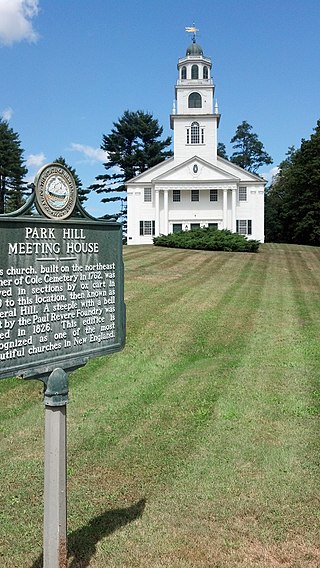
The Park Hill Meetinghouse is a historic meeting house on Park Hill in Westmoreland, New Hampshire. Built in 1764, and extensively restyled in the early 19th century, it is a fine example of Federal and Greek Revival architecture, influenced by the work of regionally prominent architect Elias Carter. The building was listed on the National Register of Historic Places in 1980. It is now owned by the Westmoreland Park Hill Meetinghouse and Historical Society.

The Second Rindge Meetinghouse, Horsesheds and Cemetery is a historic meeting house and cemetery on Old US 202 and Rindge Common in Rindge, New Hampshire. Built in 1796, it is relatively distinctive in New England as one of few such meeting houses where both civic and religious functions are still accommodated, housing both the town offices and a church congregation. The town's first cemetery, established in 1764, lies to the north of the meetinghouse. It is the resting place of many of Rindge's early settlers, and of its American Revolutionary War veterans. Behind the meetinghouse stand a row of horse sheds, the only one of the two rows of them which originally served the meetinghouse. The property was listed on the National Register of Historic Places in 1979.

The Third Fitzwilliam Meetinghouse is a historic meeting house on the village green in Fitzwilliam, New Hampshire. It presently serves as Fitzwilliam Town Hall. Built in 1817, it is a high-quality example of period church architecture, based closely on the work of regionally noted architect Elias Carter. The building was listed on the National Register of Historic Places in 1977, and was included in the Fitzwilliam Common Historic District in 1997.
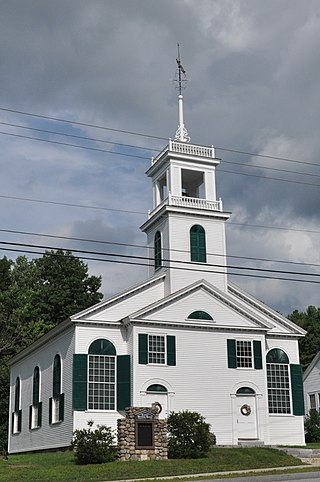
The Center Meetinghouse is a historic meetinghouse on NH 103 in Newbury, New Hampshire. The Federal-style church building was built c. 1832, a relatively late date for the style. It replaced a 1797 meetinghouse that had been located about a mile away. It is further believed to be distinctive in New Hampshire as the only Federal period church in which the pulpit is located at the rear of the auditorium. Originally built to be used by multiple religious denominations, it is now operated by a local nonprofit organization as a community center. It was listed on the National Register of Historic Places in 1979.

The Lower Warner Meetinghouse is a historic meetinghouse at 232 East Main Street in Warner, New Hampshire. Built in 1844–45, it is a little-altered example of a 19th-century Greek Revival church, which has retained nearly all of its original interior elements, as well as its exterior except for the steeple, lost to a lightning strike c. 1893. It was listed on the National Register of Historic Places in 1989.
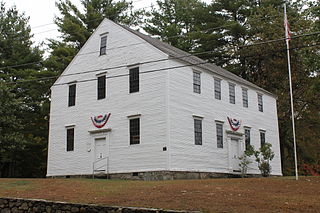
The Danville Meetinghouse is a historic colonial meeting house on North Main Street in Danville, New Hampshire. Construction on the building began in 1755 and was finished in 1760 when Danville petitioned to form a town of its own, separate from Kingston. It is the oldest meetinghouse of original construction and least-altered in New Hampshire, with a remarkably well preserved interior. The building, now maintained by a local nonprofit organization, was added to the National Register of Historic Places in 1982.

The Sandown Old Meetinghouse is a historic meeting house on Fremont Road in Sandown, New Hampshire. Built in 1773, this two-story timber-frame structure is a virtually unaltered late-Colonial civic and religious structure. It is believed to be unique in the state for its level of preservation, both internal and external. The building, now maintained by a nonprofit organization, was listed on the National Register of Historic Places in 1978, and the New Hampshire State Register of Historic Places in 2011.
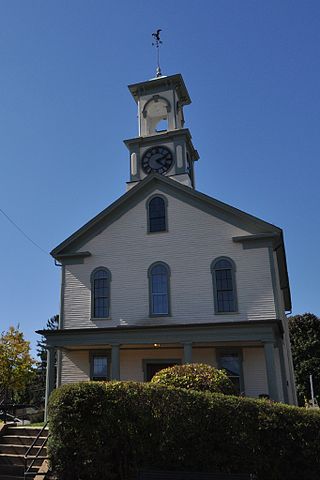
The South Meetinghouse is a historic ward hall at 260 Marcy Street in Portsmouth, New Hampshire. Completed in 1866, it is one of the city's finest examples of Italianate architecture, and a rare surviving example of a 19th-century ward hall. The building was listed on the National Register of Historic Places in 1982. It continues to be used as a community resource.

The New Durham Meetinghouse and Pound are a historic colonial meeting house and town pound on Old Bay Road in New Durham, New Hampshire. Built in 1770, the wood-frame meeting house stands at what was, until about 1850, the center of New Durham, and was originally used for both civic and religious purposes. Now a public park, the property was listed on the National Register of Historic Places in 1980.

The Dover Religious Society of Friends Meetinghouse is a historic Quaker meeting house at 141 Central Avenue in Dover, Strafford County, New Hampshire. Built in 1768 for a congregation established in the 17th century, it is the only surviving 18th-century Quaker meetinghouse in the state. The building was listed on the National Register of Historic Places in 1980.
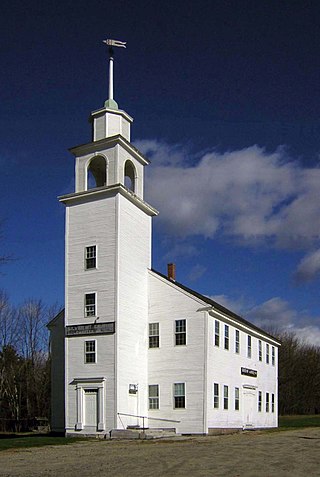
The Lempster Meetinghouse, formerly Union Hall, is a historic meeting house and church on Lempster Street in Lempster, New Hampshire. Built in 1794 to serve multiple Christian congregations, it is now a multifunction space owned by the town. The building was listed on the National Register of Historic Places in 1980.

The First Congregational Church and Meetinghouse, also known as the Church of Christ and the Townshend Church, is a historic church at 34 Common Road in Townshend, Vermont. Built in 1790 and restyled in 1840, it is one of the oldest church buildings in continuous use in the state. The building was listed on the National Register of Historic Places in 2002; the congregation was established in 1777, and is affiliated with the United Church of Christ.

The Henniker Town Hall is the town hall of Henniker, New Hampshire. The wood-frame building, built in 1786–87, is one of a small number of surviving 18th century meetinghouses in New Hampshire. At that time, its main entrance was on the long south wall, facing the raised pulpit on the north wall, and the floor was taken up by pews. The interior was decorated with high quality woodwork, which still survives. The roughly rectangular building had 1+1⁄2-story enclosed porch extensions on both sides.

The New Ipswich Town Hall is a historic academic and civic building on Main Street in the center village of New Ipswich, New Hampshire. The 1+1⁄2-story wood-frame structure was built in 1817 to serve the dual purpose of providing a town meeting place, and to provide space for a private academy. The building has been little altered since 1869, when it was substantially reconfigured solely for town use. The building was listed on the National Register of Historic Places in 1984.

The Weare Town House is a historic New England meeting house on New Hampshire Route 114 in Weare, New Hampshire. Built in 1837, it is a good example of a period town hall/church combination with Federal and Gothic Revival features. Although its religious use has ended, it continues to be used for town offices as well as civic and social functions. The building was listed on the National Register of Historic Places in 1985.
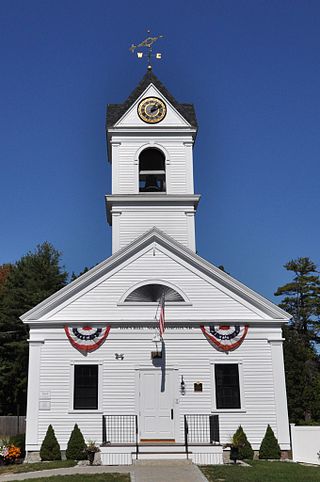
The North Hampton Town Hall is located at 231 Atlantic Avenue in North Hampton, New Hampshire. Built in 1844, it was the town's first purpose-built municipal building, and continues to be used as such. Its construction includes materials recovered from older dual-purpose religious and civic buildings, and its tower houses a Revere bell. The building was listed on the National Register of Historic Places in 2013, and the New Hampshire State Register of Historic Places in 2006.























